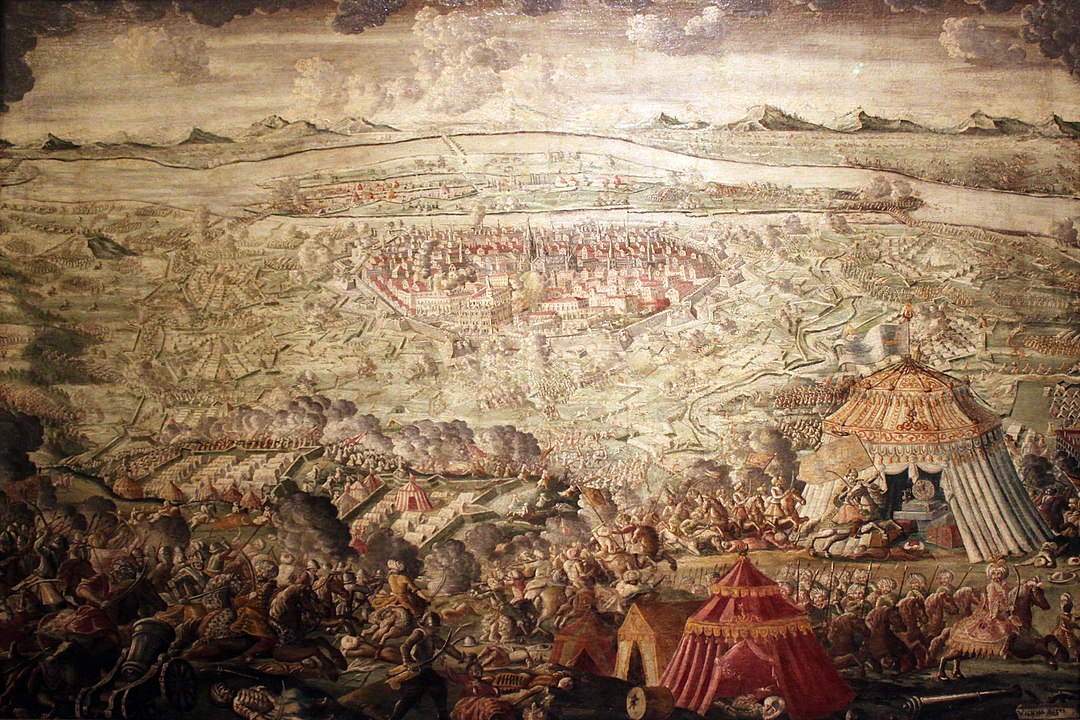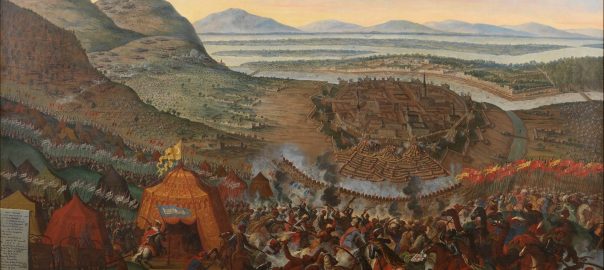1683 CE saw two events occurred, affecting three large land-based empires, that had significance for the power balance far beyond the borders of those empires. In Europe, the Habsburgs beat the Ottomans at Vienna, starting a long slow decline in Ottoman power (and giving the modern world, by some accounts, both the croissant pastry and the cappucino milky coffee into which to dip it.) In Asia, the Qing empire that had recently quelled some small rebellions in the south of their continental terrain turned its attention to Taiwan and vanquished the pesky, Ming-remnant kingdom that had established itself there nearly 20 years earlier.
I think we’ll go to Vienna first.
Habsburgs beat Ottomans at Vienna

The English-Wikipedia page on this momentous battle gives this prelude:
Capturing the city of Vienna had long been a strategic aspiration of the Ottoman Empire, because of its interlocking control over Danubian (Black Sea to Western Europe) southern Europe and the overland (Eastern Mediterranean to Germany) trade routes. During the years preceding this second siege (the first was the 1529 siege of Vienna) under the auspices of grand viziers from the influential Köprülü family, the Ottoman Empire undertook extensive logistical preparations, including the repair and establishment of roads and bridges leading into the Holy Roman Empire and its logistical centers, as well as the forwarding of ammunition, cannon, and other resources from all over the Empire to these centers and into the Balkans.
Also, since 1679 the plague had been raging in Vienna, so the Ottomans may have thought the time was right for their attack. The Grand Vizier Kara Mustafa Pasha went personally to lead it. He had with him a force of 150,000-170,000 men from both the Ottomans’ own forces and those of tributary nations. Then, this:
The main Ottoman army arrived at Vienna on 14 July; the city’s only defense force was now that of Count Ernst Rüdiger von Starhemberg’s 15,000 men. Saxon engineer Georg Rimpler, who had been employed by the [Habsburg] empire to prepare for war with the Turks, quickly hurried to prepare Vienna for the upcoming siege – much of Austria’s pre-war plans had calculated on fighting the Turks near the city of Győr, a plan made untenable by the Turkish advance…

The moment he arrived outside Vienna, Kara Mustafa sent a demand for the city’s capitulation, which Count Rüdiger refused. While the Ottomans established a camp on the hills above Vienna and started some sapper operations to breach the walls, Rüdiger was able to call in help from the (also Catholic) Polish-Lithuanian Commonwealth:
The king of Poland, John III Sobieski, prepared a relief expedition to Vienna during the summer of 1683, so honoring his obligations to the treaty (he left his own nation virtually undefended when departing from Kraków on 15 August). He covered this with a stern warning to Imre Thököly, the leader of Upper Hungary, whom he threatened with destruction if he tried to take advantage of the situation—which Thököly in fact attempted…
Sobieski’s relief force, with a total of 74,000 men and some 140 big guns, arrived in early September. WP tells us this:
Despite the multinational composition of the [relief] army and the short space of only six days, an effective leadership structure was established, centered on the king of Poland and his heavy cavalry (Polish Hussars) only, as the promised Lithuanian contingents arrived too late for the battle. The [Habsburg] Holy League settled the issues of payment by using all available funds from the government, loans from several wealthy bankers and noblemen and large sums of money from the Pope. Also, the Habsburgs and Poles agreed that the Polish government would pay for its own troops while still in Poland, but that the Emperor would pay them once they crossed into imperial territory. However, the Emperor had to recognize Sobieski’s claim to first rights of plunder of the enemy camp in the event of a victory.
Kara Mustafa Pasha was less effective at ensuring the motivation and loyalty of his forces, and in preparing for the expected relief-army attack…
At 4:00 am on [the night of 11-12] September, the Ottomans attacked, seeking to interfere with the deployment of Holy League troops. The Germans were the first to strike back. Charles of Lorraine moved forward with the imperial army on the left and other imperial forces in the center and, after heavy fighting and multiple Ottoman counterattacks, took several key positions, specifically the fortified villages of Nussdorf and Heiligenstadt. By noon the imperial army had already severely mauled the Ottomans and come close to a breakthrough. Though shattered, the Ottoman army did not crumble at that moment.

But by the end of the day, after some very tough fighting, they did.
WP adds this:
Contemporary Ottoman historian Silahdar Findiklili Mehmed Agha (1658–1723) described the battle as an enormous defeat and failure for the Ottoman Empire, the most disastrous since the foundation of Ottoman statehood in 1299. The Ottomans lost at least 20,000 men during the siege, while their losses during the battle with Sobieski’s forces amounted to around 15,000 dead (according to Podhorodecki) or 8,000–15,000 dead and 5,000–10,000 captured (according to Tucker). Casualties of the allied relief force under Sobieski’s command were much smaller, amounting to approximately 3,500 dead and wounded, including 1,300 Poles. Tucker’s estimate is slightly higher: 4,500. The 10,000 strong Viennese garrison and the civilian populace lost, due to all causes, about half of their initial number during the siege.
The Holy League troops and the Viennese took a large amount of loot from the Ottoman army, which Sobieski vividly described in a letter to his wife a few days after the battle:
“Ours are treasures unheard of . . . tents, sheep, cattle and no small number of camels . . . it is victory as nobody ever knew before, the enemy now completely ruined, everything lost for them. They must run for their sheer lives . . . General Starhemberg hugged and kissed me and called me his saviour.”
The outcome was, of course, devastating for the Ottomans, who had invested a lot in preparing for it. But it was particularly devastating for Kara Mustafa. As his page on WP notes, after the defeat this happened:
The defeat cost Mustafa his position, and ultimately, his life. On 25 December 1683, Kara Mustafa was executed in Belgrade at the order of Mehmed IV. He suffered death by strangulation with a silk cord, which was the method of capital punishment inflicted on high-ranking persons in the Ottoman Empire. His last words were, “Am I to die?” and “As God pleases.”
So much more civilized than hanging, drawing, and quartering, as still practiced in England…
Mainland Chinese take Taiwan
Back in 1662, the pro-Ming warlord known as Koxinga had retreated from the Chinese mainland to Taiwan/Formosa, kicking the Dutch out of the chunk of southwest Taiwan that they had ruled. He still harbored longterm plans to be able to unseat the Qing (originally Manchu) dynasty ruling on the mainland. But this page on WP tells us that he realized,
that developing his forces in Taiwan into a large enough threat to unseat the Qing would not be achieved in the short term, [so he] began transforming Taiwan into a practically proper, albeit preferably temporary, seat of power for the southern Ming loyalist movement. Replacing the Dutch system of government previously used in Taiwan, Koxinga instituted a Ming-style administration, the first Chinese governance in Taiwan.
Koxinga died in 1662, but his dynasty, the Zheng dynasty, continued ruling that chunk of Taiwan, which was called the Kingdom of Tungning.
In 1678 or so, the Kangxi Emperor (the Qing guy ruling in Beijing) imposed a blockade around Taiwan. Then in 1683 he appointed Adm. Shi Lang as commander-in-chief of the Qing Navy and sent him “with a force of about 21,000 men and 240 warships” to invade Tungning. WP also tells us this:
A few days before the battle, Shi Lang had bought cannons from the Dutch and so his ships were better armed. On July 12, 1683, Qing naval forces took Hujing Island and Tongpan Island in the early stages of the battle. During the battle, the Qing forces smashed into [the Tungning admiral] Liu’s force and broke up his formation. The defenders still fought bravely. The Qing ships were larger, better armed, and had more ammunition and within an hour, most of the Tungning ships were at the bottom of the ocean. However the remaining ships continued to fight.
In the end, the Tungning ships ran out of ammunition but hand-to-hand combat still continued. When his flagship and commander Liu ran out of ammunition, the remaining ships surrendered, some of them burning for three days and nights. Many generals and soldiers refused to surrender but rather chose to drown as a show of loyalty to the former Ming dynasty, thus ending the battle…
After surrendering, Liu was about to commit suicide, but he was stopped by Shi Lang. They had a brief talk about the battle and Liu was released. With the destruction of Liu’s fleet, Penghu surrendered and Tungning soldiers deserted in droves. It became obvious to the court on Taiwan that they were now defenceless. A few days later, Zheng Keshuang and his court formally surrendered to the Qing dynasty, ending the Tungning kingdom.
These details from Shi Lang’s page on WP are interesting:
Following this successful campaign, Shi Lang returned to the Chinese mainland and worked hard to persuade the Kangxi Emperor to make Taiwan part of China’s recognized territory. At the time, there was opposition among many within the Qing government toward the annexation of Taiwan, arguing that its maintenance would become an economic burden on the empire. However, the Kangxi Emperor accepted Shi Lang’s views, and in 1684 Taiwan was divided into three counties and established as a prefecture of Fujian province.

Shi Lang was declared the “General Who Maintains Peace on the Seas” (靖海将军) and given the hereditary rank of marquis. At his own request, he was specially granted the privilege of wearing an honorary peacock feather. [?] Shi Lang continued at his post in Fujian, seizing almost half of the developed land in southern Taiwan for his own profit. Shi annually extorted monetary resources from rich and poor local communities alike, and instituted policies that deliberately aimed to isolate Taiwan from the rest of the Qing Empire… Although he was later charged with arrogance, in 1688 the Kangxi Emperor received Shi Lang in audience in Beijing and allowed him to sit in the imperial presence, reiterating his confidence in him. Shi Lang returned to Fujian and remained in office there until his death in 1696.





